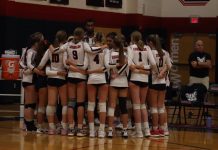By Catelin Owens

According to the Centers for Disease Control, high school athletes account for an estimated two million injuries, 500,000 doctor visits, and 30,000 hospitalizations each year. Nearly half of these high school injuries are from the overuse of a muscle.
Rob Babcock is a physical therapist at the Veteran Affairs Hospital in Southern Nevada that specializes in overuse sport injuries among new athletes.
“There are many types of overuse injuries, so treatment can vary quite a bit depending on the area and extent of the injury,” Babcock said, “The goal would be to get the patient back to the highest level of use. But, if you continue to participate in sports, a modified training program would be important so you don’t cause more damage to the area.”
The most common injuries vary depending on the sport, yet injuries seen in all high school sports can prove critical.
As a result, athletes have to wrap their ankles and wear ankle braces because of the vigorous practices they have. “The most common injuries I see are sprained ankles,” Jenna Levy, Coronado athletic trainer, said.
To prevent an injury, warm-ups are recommended before any practice.
“We do a lot of dynamic stretching, and at the end, we do a little more static stretching where they just sit still,” Alison Donohue, women’s volleyball coach, said.
Many athletes aren’t aware they are sustaining a long term injury and just ignore the pain in order keep playing. For some athletes, icing the pain away when they get home is the closest thing to medical help they receive.
Miranda McGovern is a sophomore and has been a dancer for ten years. Because of the strain placed on her body from intensive practices, her body has begun to face the consequences.
“I have tendinitis in my achilles tendon, and I didn’t know until it became a problem, and I couldn’t dance,” McGovern said. “I had to take a break because it was inflamed enough that it could break.”











